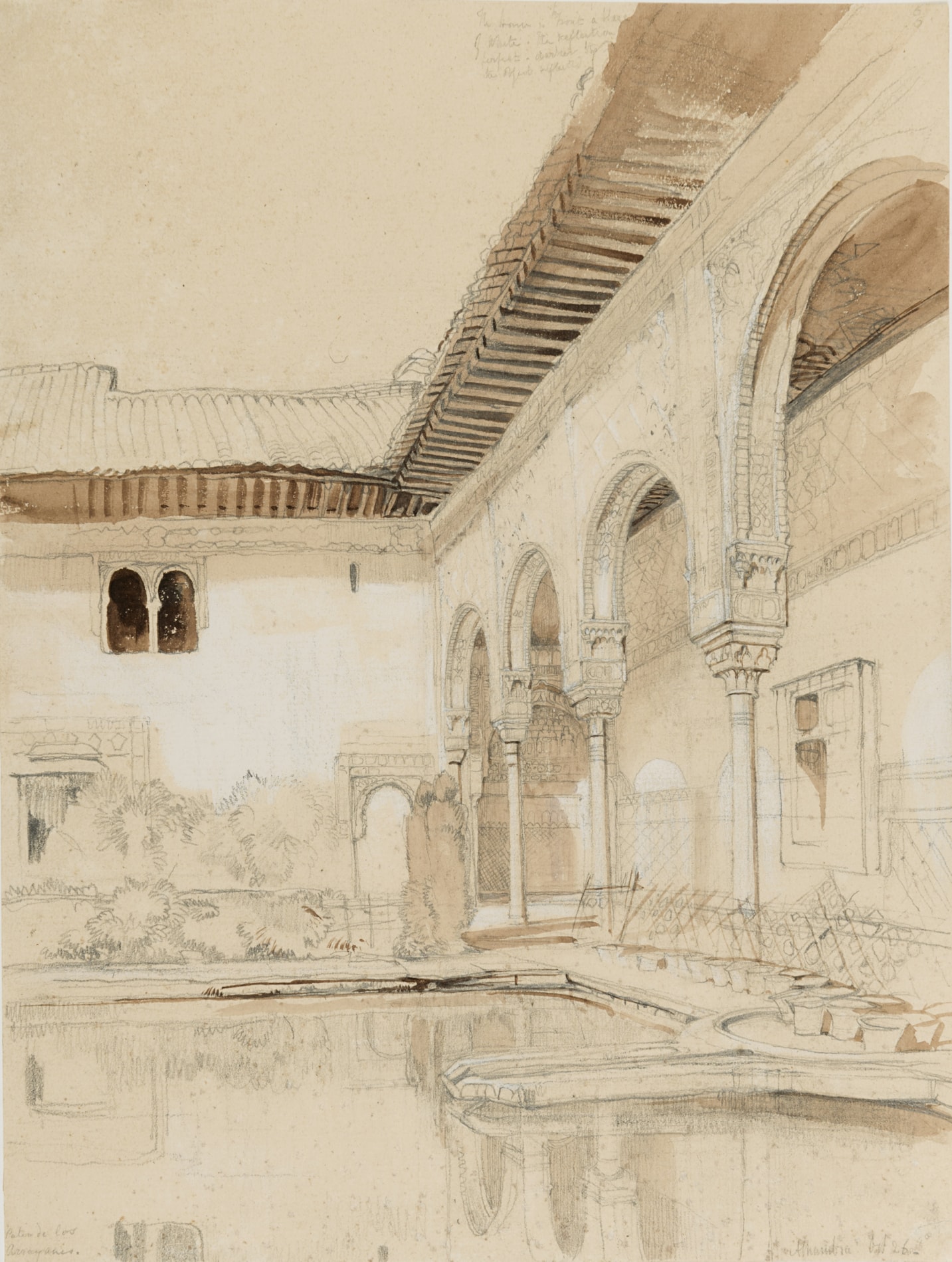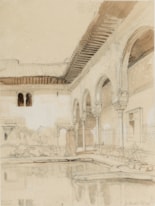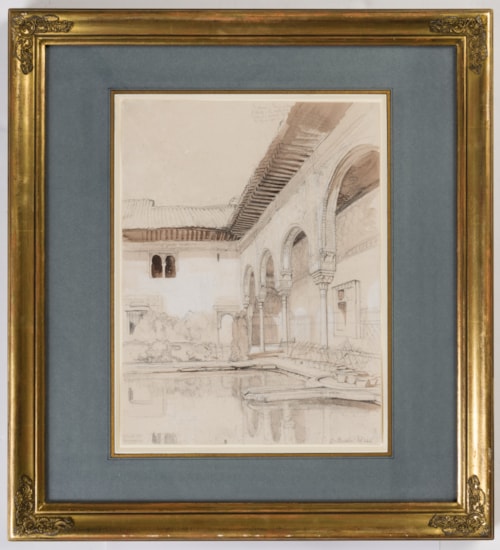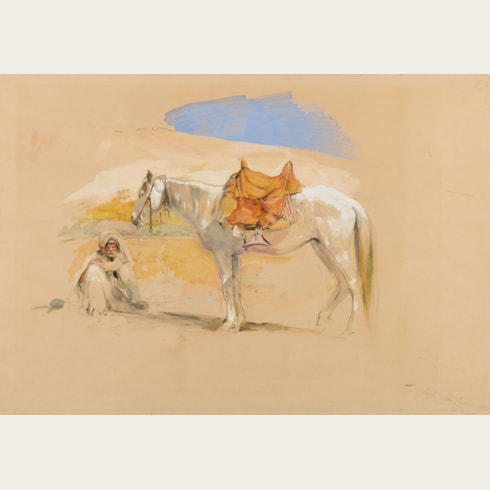John Frederick LEWIS
(London 1805 - Walton-on-Thames 1876)
The Patio de los Arrayanes at the Alhambra, Granada
Sold
Pencil and brown wash, heightened with white gouache.
Inscribed by the artist The house in Front a blaze / of White. The reflection / perfect. Darken this / for objects reflected at the upper right.
Further inscribed Patio de los / Arrayanes at the lower left and Alhambra. Oct.26 at the lower right.
282 x 212 mm. (11 1/8 x 8 3/8 in.)
Inscribed by the artist The house in Front a blaze / of White. The reflection / perfect. Darken this / for objects reflected at the upper right.
Further inscribed Patio de los / Arrayanes at the lower left and Alhambra. Oct.26 at the lower right.
282 x 212 mm. (11 1/8 x 8 3/8 in.)
The years John Frederock Lewis spent in Spain, between 1832 and 1834, saw him producing numerous drawings, watercolours and lithographs of local sights, figures, costumes, buildings and landscapes. Spanish themes dominated his exhibited output of finished watercolours for most of the succeeding years; indeed, between 1834 and 1839, every one of Lewis’s exhibited works was of a Spanish subject. Together with two volumes of lithographs published in 1835 and 1836 - Sketches and Drawings of the Alhambra, made during a residence in Granada in the Years 1833-4 and Lewis’s Sketches of Spain and Spanish Character - these works earned the artist the nickname ‘Spanish Lewis’.
In the autumn of 1832, after a period of time in Madrid, Lewis settled in Granada in Andalusia. There he stayed with his patron and friend Richard Ford at the Casa Sanchez, an old house on the grounds of the Alhambra palace. Lewis was captivated by the Alhambra, the hilltop fortress and palace of the Nasrid dynasty that had ruled Granada for two hundred years until the end of the 15th century. He made a number of drawings of the Moorish architecture of the palace, situated on a rock high above the city, with a view to publishing a series of lithographs on his return to England. (Many of these drawings were indeed reproduced as lithographs, appearing in Sketches and Drawings of the Alhambra, published in 1835, and Lewis’s Sketches of Spain and Spanish Character, which was issued the following year.) The artist remained in Granada until 1834, when he moved on to Seville.
Lewis’s Alhambra drawings have long been recognized as among the finest works of his Spanish period. As the artist’s grand-nephew noted, ‘Lewis’s sketches of the Alhambra…are important as being his first sustained attempt at architectural drawing. Furthermore, in the Alhambra he was close to the fascinating relics of an Islamic culture for the first time. Lewis was captivated by it all: the elegance of this palace made for indolent enjoyment; the traceries of its peristyles; the latticed jalousies through which some dark-eyed princess might observe unseen; the cool halls and the tinkle of water everywhere.’
The present sheet, drawn on the 26th of October 1832, depicts the interior courtyard known as the Patio de los Arrayanes, or Courtyard of the Myrtles, so named for the myrtle bushes that border the central pond, which is fed by fountains at either end. Almost certainly made on the spot, this is very much a working drawing, and includes the artist’s colour notes in pencil.
A more finished watercolour of the same view, but from a slightly different vantage point, was with Stephen Ongpin Fine Art in 2014 and is today in a private American collection. Another drawing of the Patio de los Arrayanes, seen from the opposite end of the pond, is in the Bolton Museum, while a watercolour sketch of the courtyard is in the collection of Eton College. Other drawings by Lewis of the Alhambra are today in the collections of the British Museum and the Victoria and Albert Museum in London, the Fitzwilliam Museum in Cambridge and the Ashmolean Museum in Oxford, as well as the Ackland Art Museum at Chapel Hill, North Carolina and the Patronato de la Alhambra y Generalife in Granada.
The first known owner of this drawing was Charles Baring Wall (1795-1853), who served as Member of Parliament for, at various times, the constituencies of Guildford, Wareham, Weymouth and Salisbury. At his death in 1853 he bequeathed his entire estate to his cousin, the banker Thomas Baring (1799-1873), who was briefly the Conservative MP for Great Yarmouth and later served as MP for Huntingdonshire for nearly thirty years.
In the autumn of 1832, after a period of time in Madrid, Lewis settled in Granada in Andalusia. There he stayed with his patron and friend Richard Ford at the Casa Sanchez, an old house on the grounds of the Alhambra palace. Lewis was captivated by the Alhambra, the hilltop fortress and palace of the Nasrid dynasty that had ruled Granada for two hundred years until the end of the 15th century. He made a number of drawings of the Moorish architecture of the palace, situated on a rock high above the city, with a view to publishing a series of lithographs on his return to England. (Many of these drawings were indeed reproduced as lithographs, appearing in Sketches and Drawings of the Alhambra, published in 1835, and Lewis’s Sketches of Spain and Spanish Character, which was issued the following year.) The artist remained in Granada until 1834, when he moved on to Seville.
Lewis’s Alhambra drawings have long been recognized as among the finest works of his Spanish period. As the artist’s grand-nephew noted, ‘Lewis’s sketches of the Alhambra…are important as being his first sustained attempt at architectural drawing. Furthermore, in the Alhambra he was close to the fascinating relics of an Islamic culture for the first time. Lewis was captivated by it all: the elegance of this palace made for indolent enjoyment; the traceries of its peristyles; the latticed jalousies through which some dark-eyed princess might observe unseen; the cool halls and the tinkle of water everywhere.’
The present sheet, drawn on the 26th of October 1832, depicts the interior courtyard known as the Patio de los Arrayanes, or Courtyard of the Myrtles, so named for the myrtle bushes that border the central pond, which is fed by fountains at either end. Almost certainly made on the spot, this is very much a working drawing, and includes the artist’s colour notes in pencil.
A more finished watercolour of the same view, but from a slightly different vantage point, was with Stephen Ongpin Fine Art in 2014 and is today in a private American collection. Another drawing of the Patio de los Arrayanes, seen from the opposite end of the pond, is in the Bolton Museum, while a watercolour sketch of the courtyard is in the collection of Eton College. Other drawings by Lewis of the Alhambra are today in the collections of the British Museum and the Victoria and Albert Museum in London, the Fitzwilliam Museum in Cambridge and the Ashmolean Museum in Oxford, as well as the Ackland Art Museum at Chapel Hill, North Carolina and the Patronato de la Alhambra y Generalife in Granada.
The first known owner of this drawing was Charles Baring Wall (1795-1853), who served as Member of Parliament for, at various times, the constituencies of Guildford, Wareham, Weymouth and Salisbury. At his death in 1853 he bequeathed his entire estate to his cousin, the banker Thomas Baring (1799-1873), who was briefly the Conservative MP for Great Yarmouth and later served as MP for Huntingdonshire for nearly thirty years.
After some early success as a painter, mostly of animal subjects (an interest he shared with his childhood friend and neighbour Edwin Landseer), John Frederick Lewis seems to have largely given up painting around 1830, in favour of drawings and finished watercolours. These works were exhibited at the Society of Painters in Water-Colours (to which he had been elected as an associate in 1827, at the age of just twenty-one), the Royal Academy, the British Institution and elsewhere. He made his first trip abroad in 1827, visiting Belgium, Germany, Switzerland and Italy. Between 1832 and 1834 Lewis lived and worked in Spain, producing numerous drawings, watercolours and lithographs of local sights, figures, costumes, buildings and landscapes. Spanish subjects dominated his exhibited output of finished watercolours for most of the succeeding years, as well as two volumes of lithographs published in 1835 and 1836, earning him the nickname ‘Spanish Lewis’. In 1837 Lewis left London to travel to Italy, where he spent two years, and from there went on to Greece, Albania and Turkey before eventually settling in Egypt at the end of 1841.
Lewis resided in Cairo for ten years, living as an Oriental gentleman in an elegant Ottoman house in the Azbakiyyah quarter of the city, dressing in the Turkish manner and enjoying what one visitor, the writer William Makepeace Thackeray, described as a ‘dreamy, hazy, lazy, tobaccofied life.’ He produced a large number of watercolours and drawings during his decade in Egypt before his return to England in 1851. For the remainder of his career he painted Orientalist subjects inspired by his years in the East, and based largely on the drawings made in Cairo. These depictions of mosques, bazaars, Eastern interiors, desert encampments and imaginary harem scenes proved immensely popular with collectors. In 1855 Lewis was elected President of the Society of Painters in Water-Colours, although the previous year he had also begun to exhibit paintings at the Royal Academy. His growing interest in oil painting, at the expense of watercolours, led him in February 1858 to resign from the Old Water-Colour Society, and for the remainder of his career Lewis’s exhibited works were mainly paintings. Elected an Associate of the Royal Academy in 1859 and an Academician in 1864, Lewis showed regularly at the Academy until his death in 1876.
Lewis’s paintings and watercolours of exotic Eastern subjects, executed in a meticulous and detailed manner, remained popular with collectors and connoisseurs throughout the later stages of his career. As his fellow artist and traveller Edward Lear noted, in a letter to Lewis’s wife written the year before the painter’s death, ‘There have never been, and there never will be any works depicting Oriental life – more truly beautiful and excellent – perhaps I might say - so beautiful and excellent. For, besides the exquisite and conscientious workmanship, the subjects painted by J. F. Lewis were perfect as representations of real scenes and people.’
Provenance
Charles Baring Wall MP, London and Norman Court, West Tytherley, Hampshire
By inheritance to his cousin, Thomas Baring MP, London and Norman Court, West Tytherley
Thence by descent.
By inheritance to his cousin, Thomas Baring MP, London and Norman Court, West Tytherley
Thence by descent.








